EinStein a la Card
EinStein a la Card is a variant of the game
EinStein würfelt nicht.
Readers are assumed to be familiar with the rules of normal Ewn.
The Rules of "EinStein a la Card"
(also called "Quanten MauMau" in the early years)
Copyright Ingo Althöfer, June 2005 and February 2012;
There are two players, the normal 5x5 board, 6 pieces (with
numbers 1 to 6) for each player and a 6-sided die, Besides, there is
a set of 18 cards for each player. The cards include
twelve cards with numbers: 2 x 1, 2 x 2, 2 x 3, 2 x 4, 2 x 5, 2 x 6;
and six special cards:
Murphy Light, Full Murphy, Da Capo, Dirac, Heisenberg, Schroedinger.
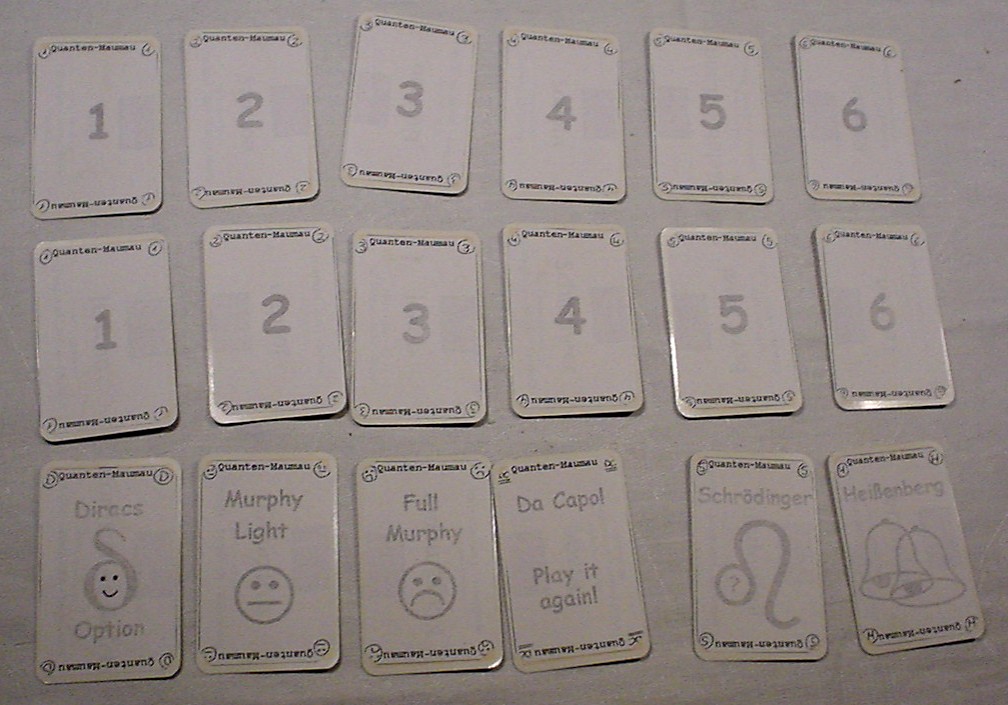
The meanings of the special cards are as follows.
Murphy Light:
The opponent dictates which of your stones you have
to move. You are free to make any legal move with this stone.
Full Murphy:
The opponent makes the whole move for you. He decides which
stone and also which move of this stone.
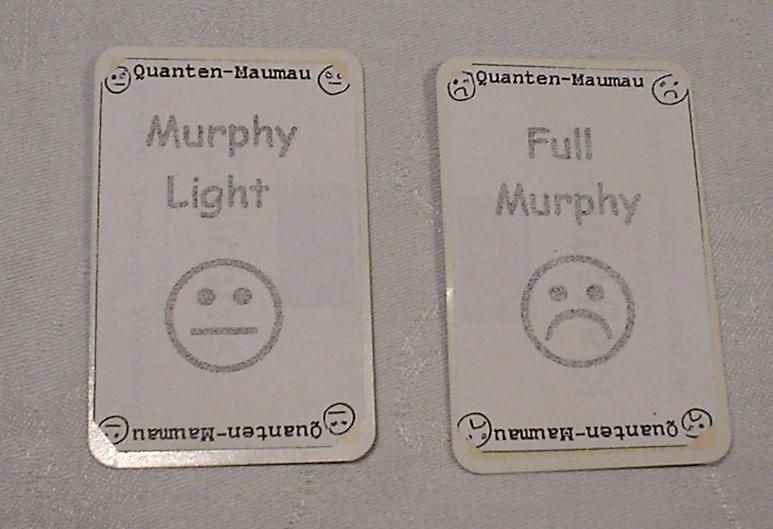
The name of the two cards comes from Edward Murphy's Law,
one of the fundamental rules of thumb in practical physics.
Da Capo:
Make a move according to the last card played by the opponent.
When this was also a "Da Capo" move, make a move according to
your last card.
Dirac:
Play any legal move with any of your stones.
The name comes from the distribution of Paul Dirac's
delta function. The normal die distribution
(1/6 , 1/6 , .... , 1/6 ) is changed to ( .., 0 , 1 , 0 ...)
with probability "1" at any of the six possible positions.
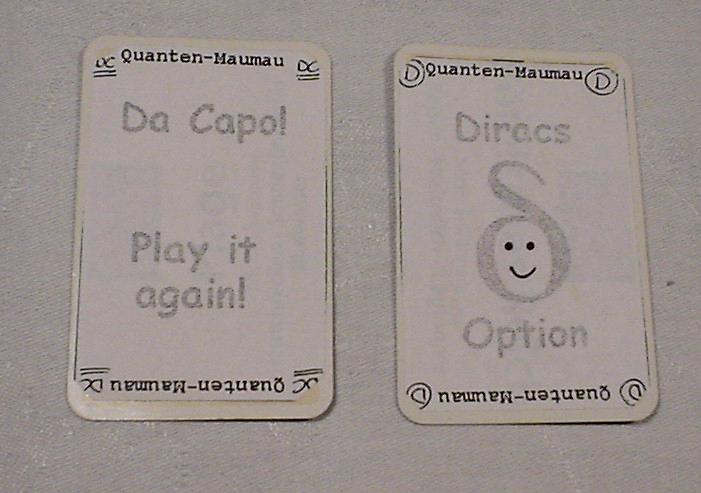
Schroedinger:
Mark any of the stones on the board (either a stone of your own or
one of the opponent). Roll the die. When the outcome is high
(meaning 4 or 5 or 6), delete this stone from the board. When
the outcome is low (1 or 2 or 3), nothing happens. The name
relates to Erwin Schroedinger's Gedanken-Experiment with a cat in the box.
After the experiment the cat will be alive with probability 1/2.
Heisenberg:
Roll the die. When the outcome is "i", then you are free to
interpret it either as j = "i-1", "i", or "i+1". Then make
a legal move according to your j.
The name relates to Werner Heisenberg's uncertainty principle.
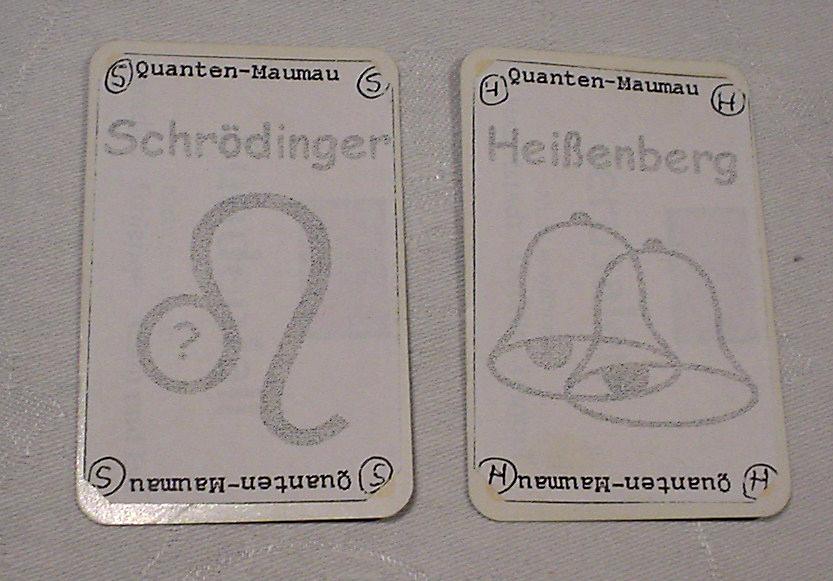
*************
Side remark: On the Heisenberg card, the name is written with an error.
Thanks to Hartmut T. for pointing this out back in 2006. By reasons of
nostalgy we did not correct the wrong letter.
*************
A game of EinStein a la Card runs as follows.
The stones are set up randomly in their starting corners of the board.
For each player the 18 cards are shuffled and put on a heap.
Each player takes the top two cards in his hand, invisible to
the opponent. The player to move plays one of the cards in his hand
and realizes a corresponding action. For instance, a card with
number 4 means that stone no. 4 has to be moved (or a stone
with neighboring number if ...). The meanings of the special cards
are explained above.
After the action the played card is put aside,
and the player takes a new second card from his heap.
When at the end all cards are played and noone has reached
his goal the game is a draw. (This happens only in very rare
cases.)
A Sample Game
We show a sample game in photos. The cards are shown open;
in real play the players see only their own cards - and
the single card played by the opponent.
It is not necessary to study
each position. Quick readers may simply rush through the
game and take a closer look only at "interesting" moments.
My comments are given always below the photos.
At the very end we propose two settings for handicap play.
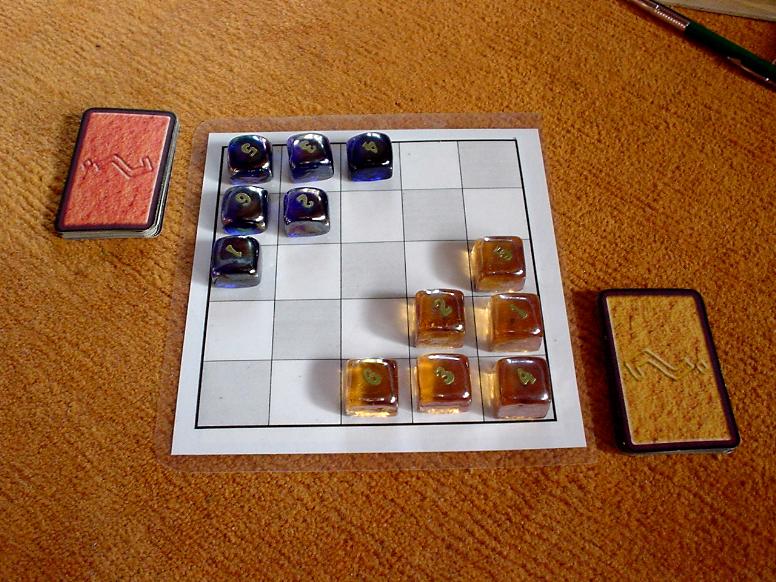
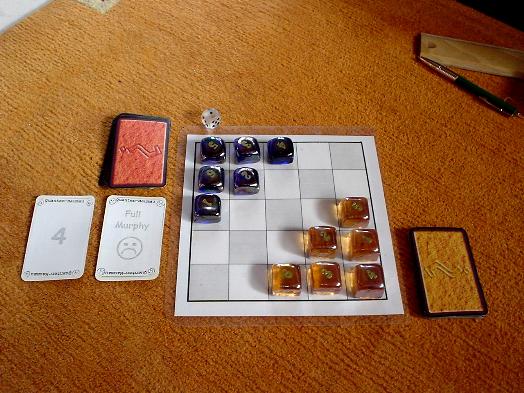
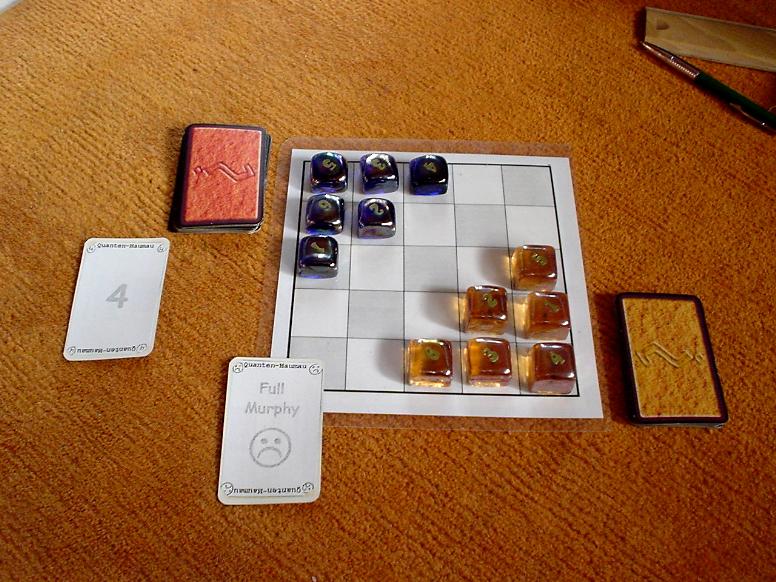
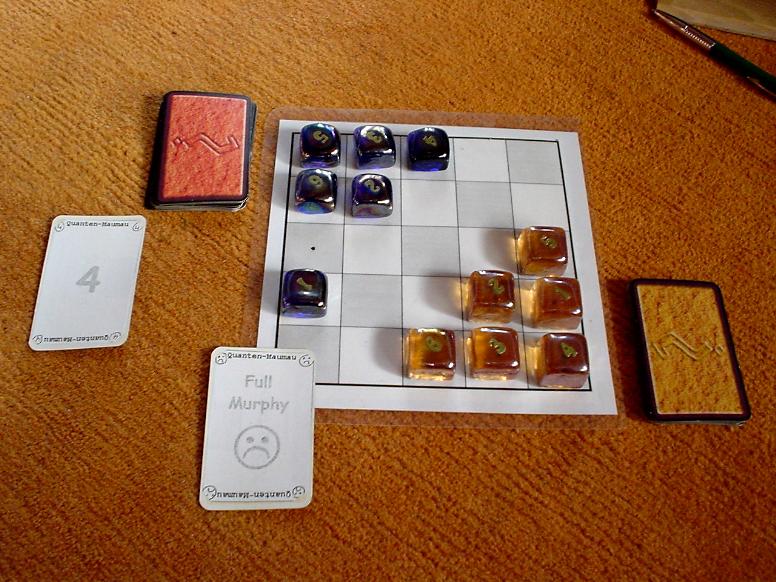

Blue was to start. One of his two cards was Full Murphy, the worst
possible of all cards. Blue decided to play it directly in the hope
that an opponent's move in this early phase would not have very
bad consequences. Orange decided to move Blue's "1" in the offside.
In normal play by experienced players, such a move would never be made.
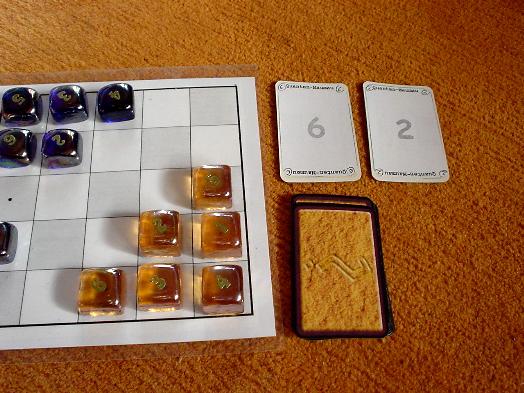
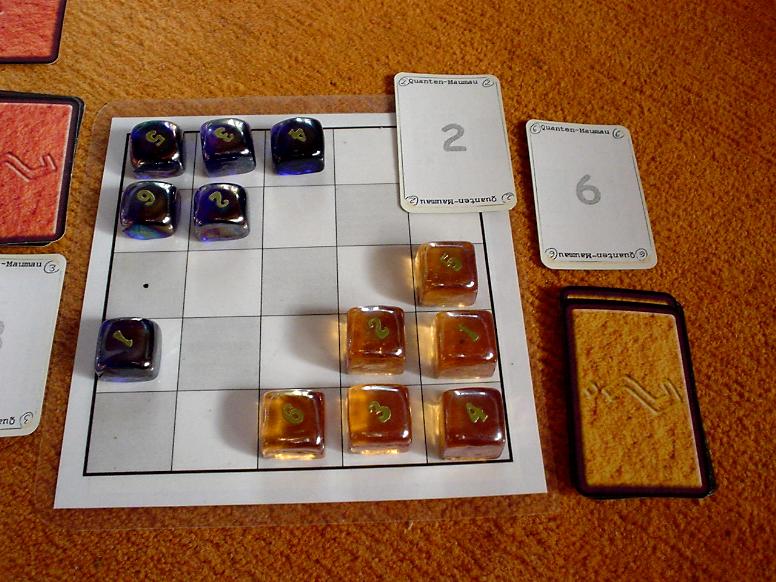
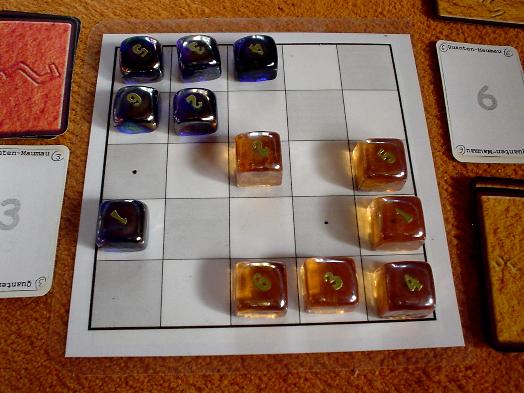
A rather normal situation for Orange. He decides for
an attack in the center.
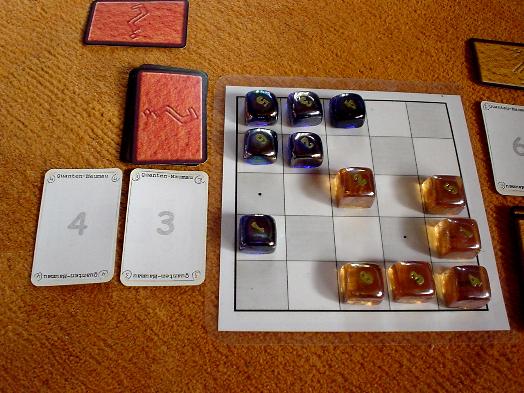
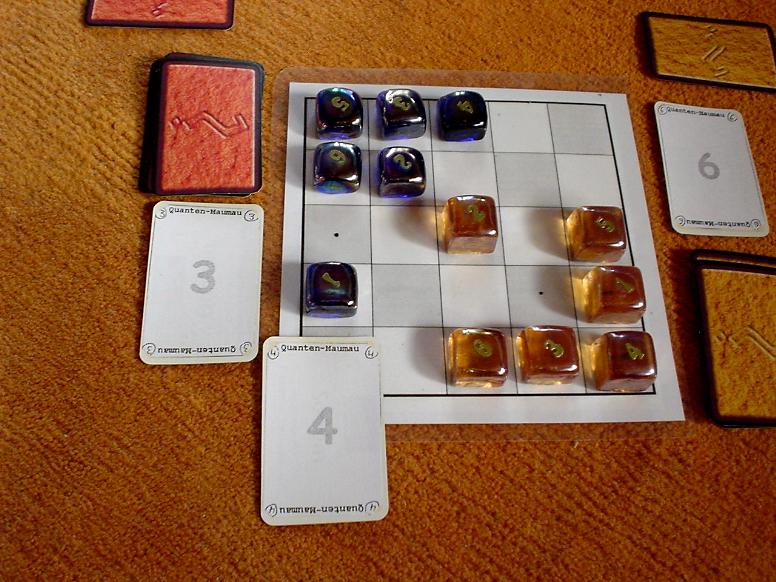
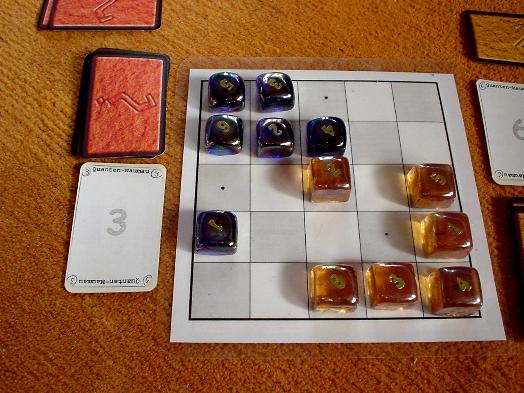
Normal cards and normal move by Blue.
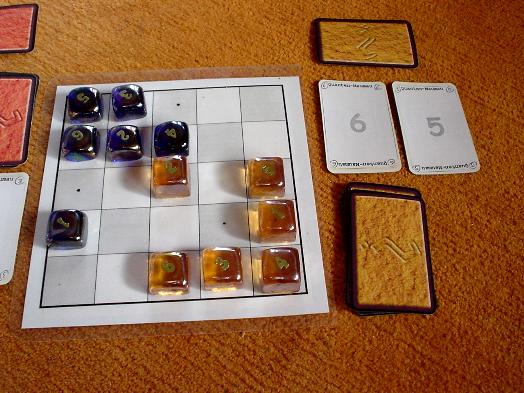
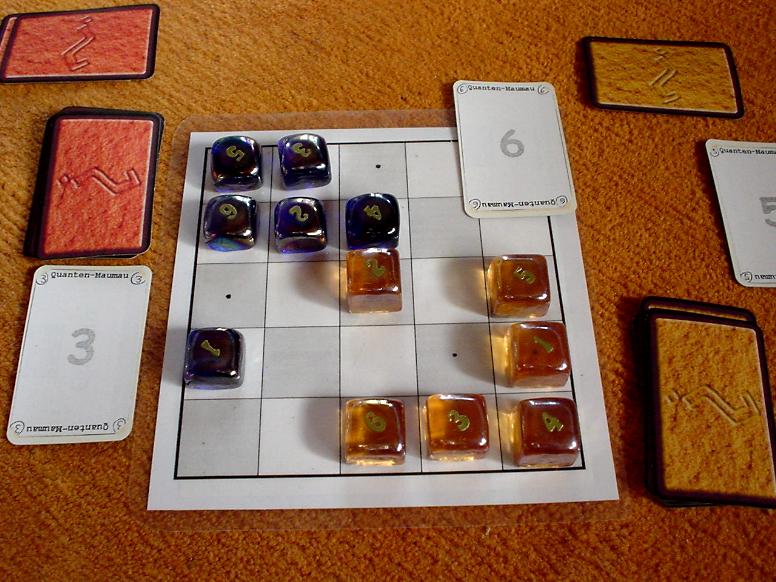
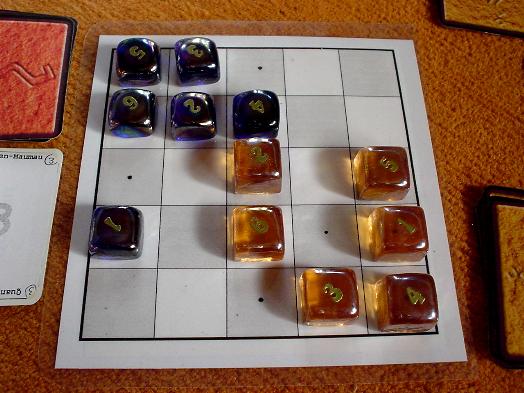
Normal, normal.
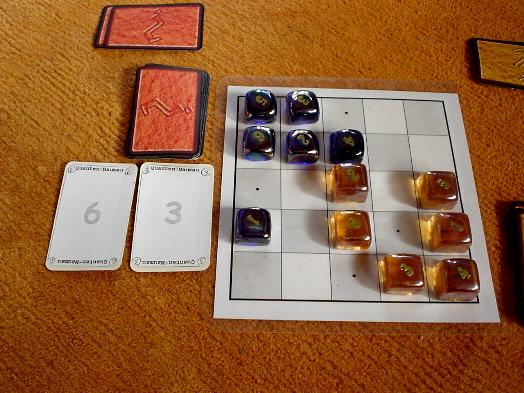
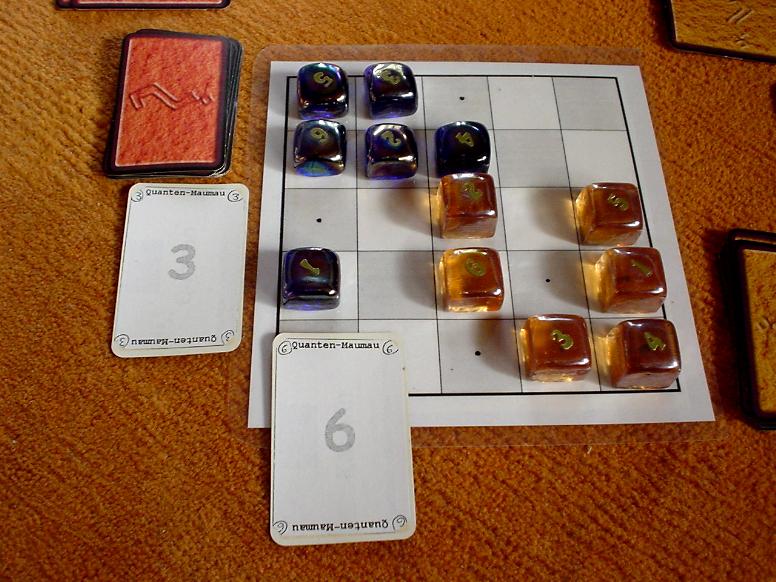
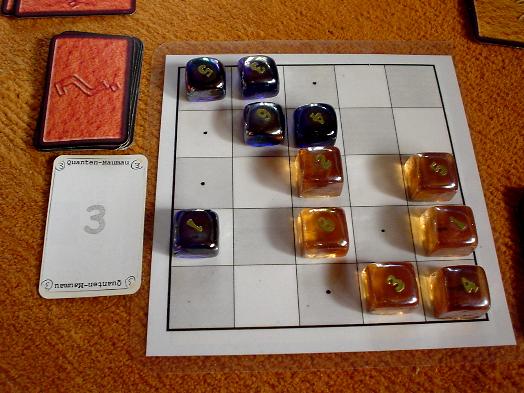
What shall I say? Nothing special...
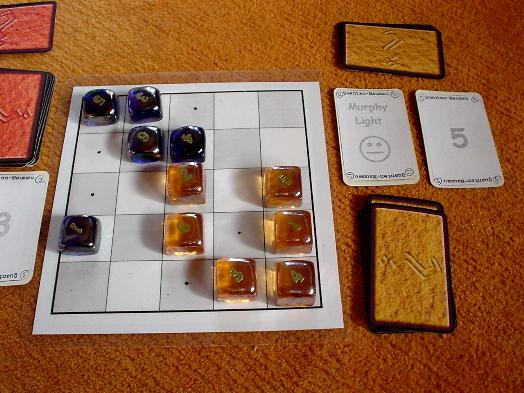
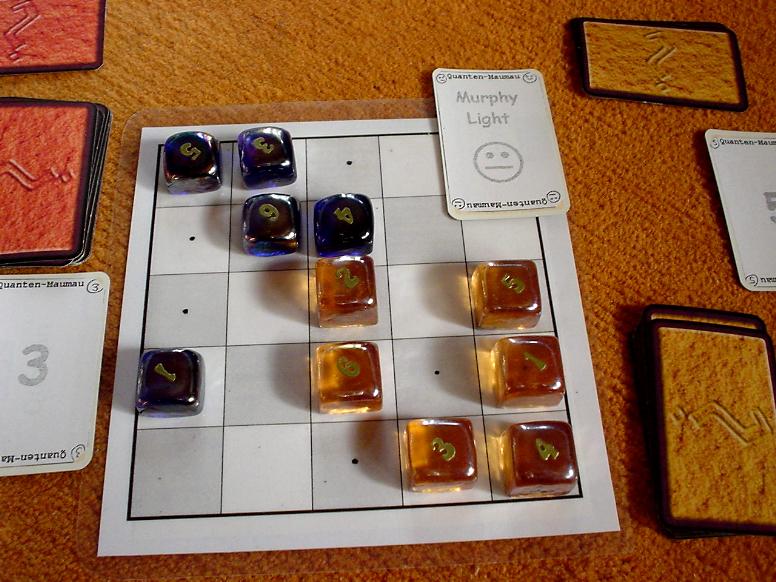
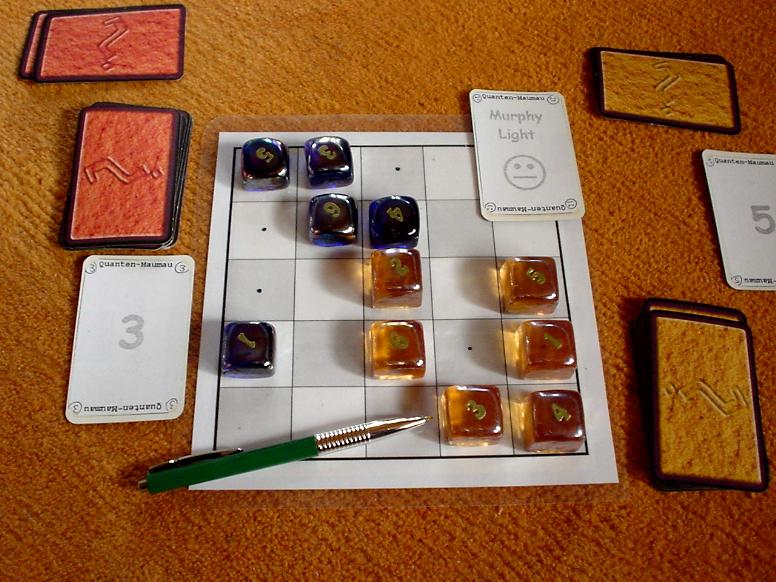
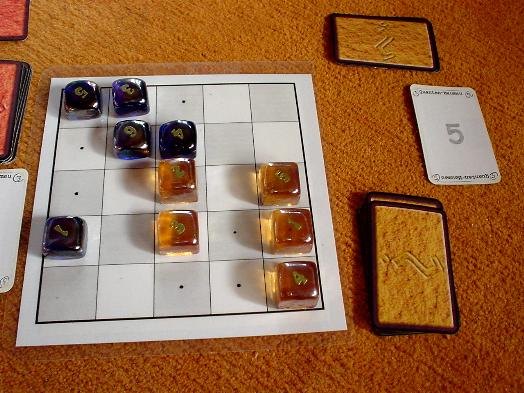
Orange plays his Murphy Light. Blue requires the orange 3 to move
(marked by the pen in photo 3).
Orange captures his own 6 with the 3.
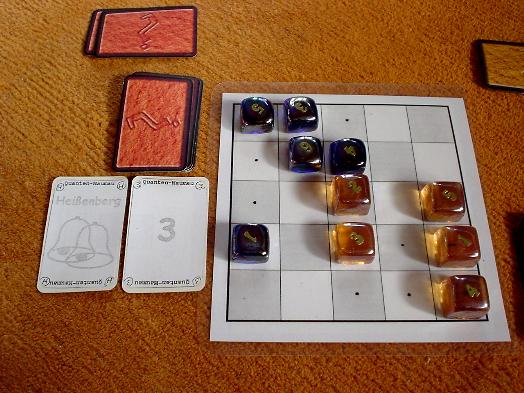
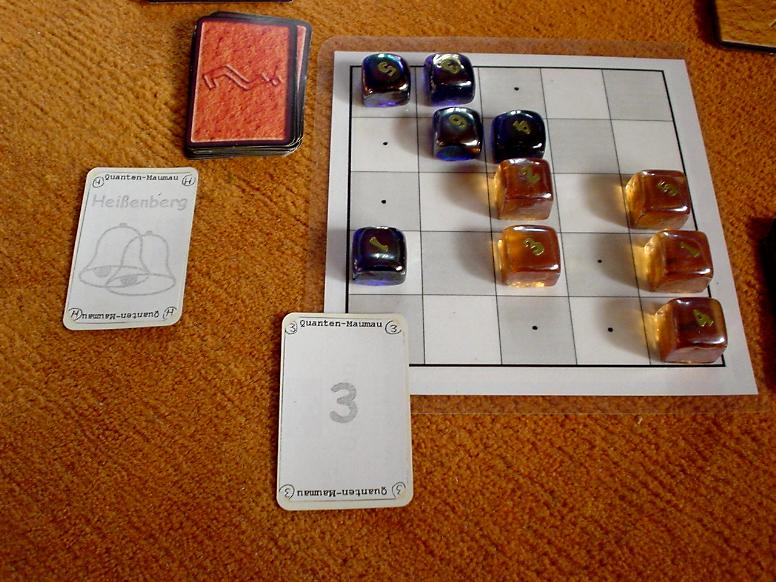
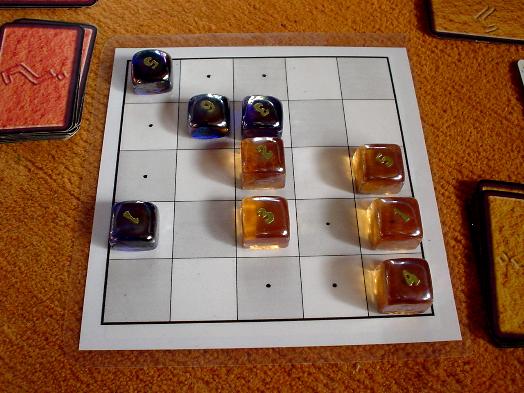
Blue received Heisenberg from the heap. He decides to play the 3,
keeping the rather valuable Heisenberg for a later moment.
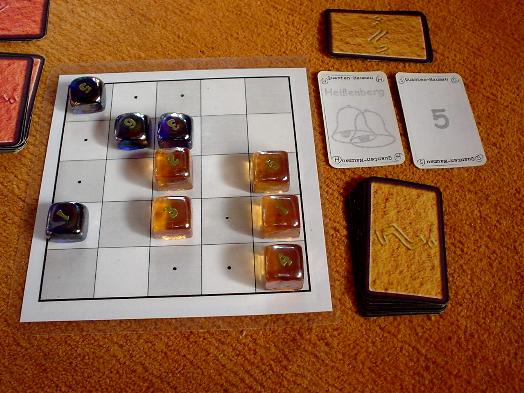
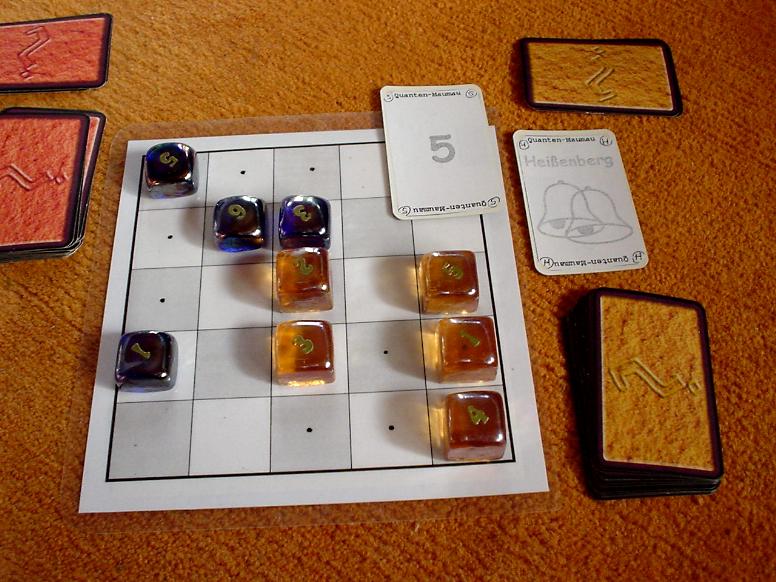
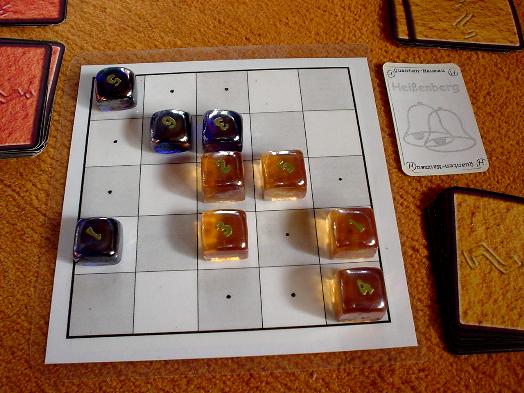
An invasion of Heisenbergs! Orange also got his one.
Also he keeps it for a later moment.
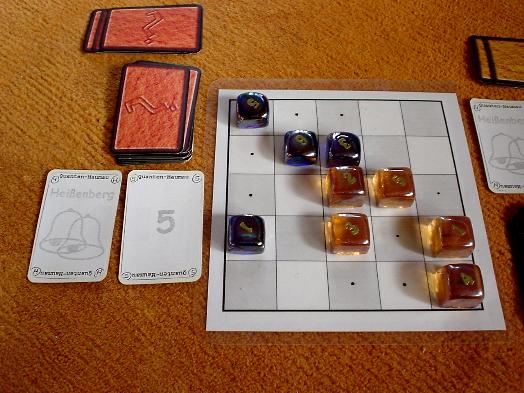
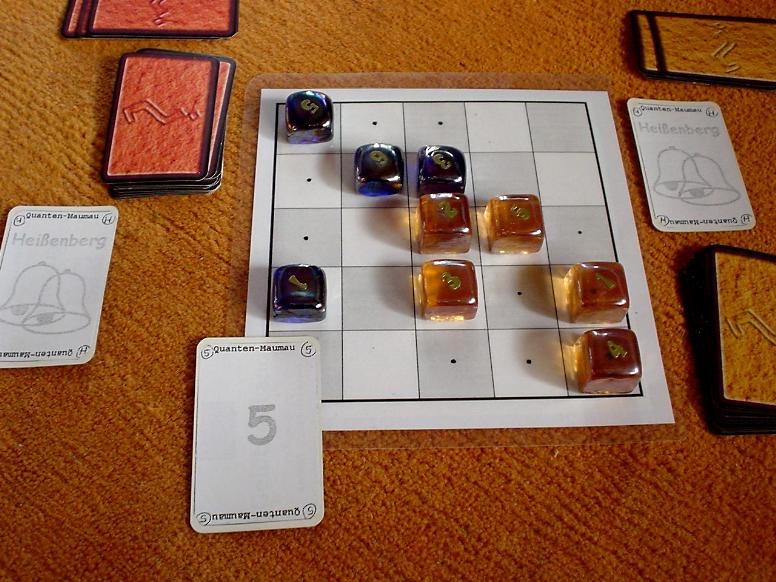
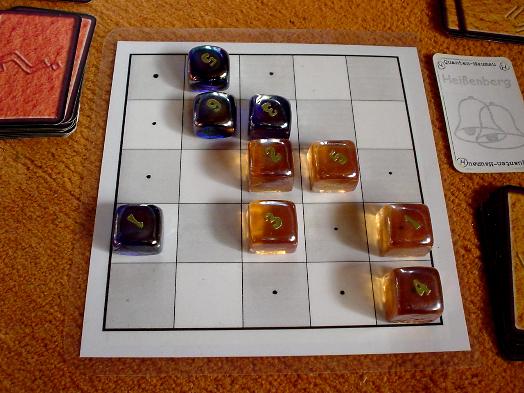
Nothing special to report.
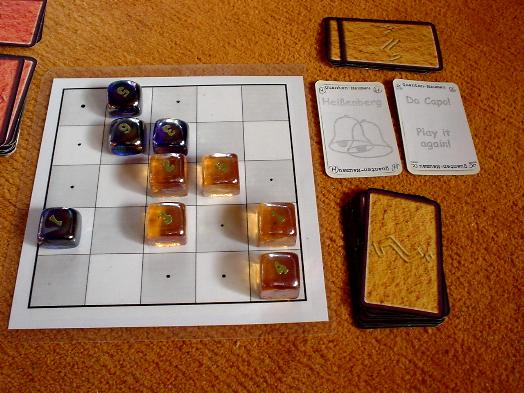
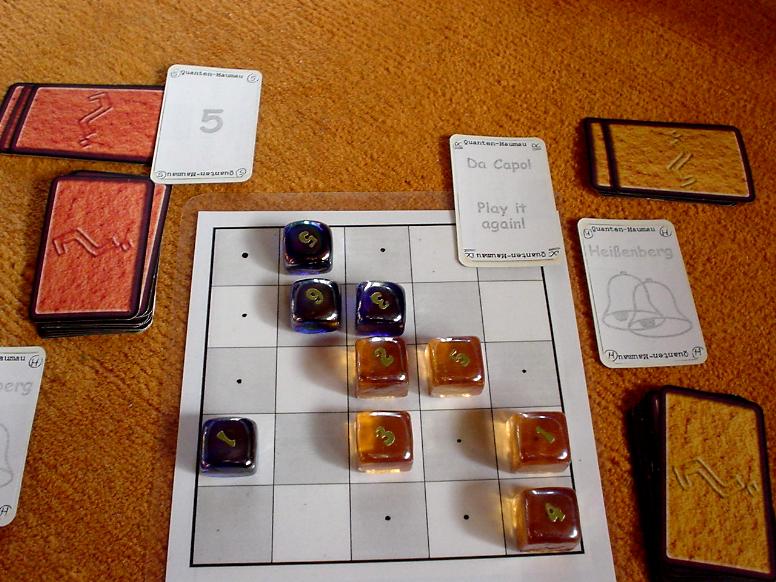
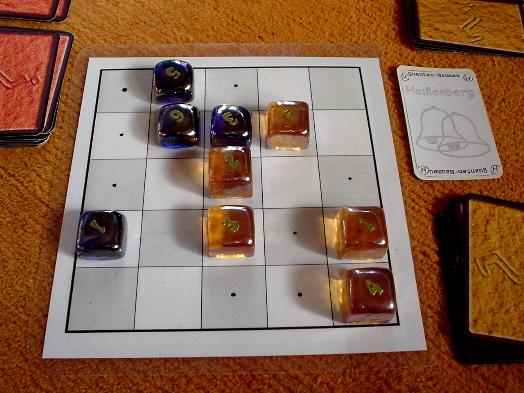
Oh. Da Capo played by Orange. Blue's last played card had been a 5.
So, Orange also plays a 5 now.
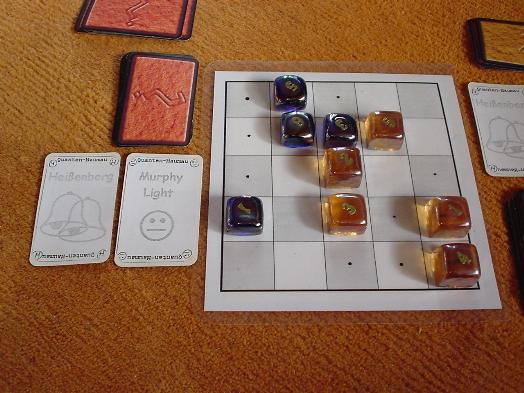
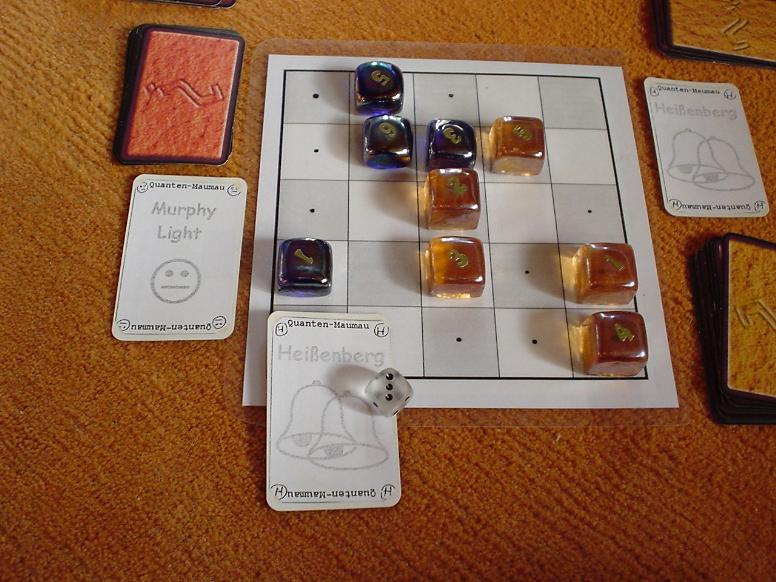
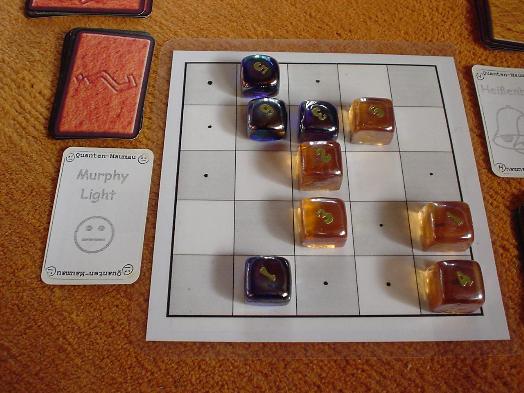
Now Blue has two rather extreme cards on hand: the negative "Murphy Light"
and the positive "Heisenberg". Blue selects Heisenberg, rolls a 3,
interprets it as a 2, and moves his 1-stone.
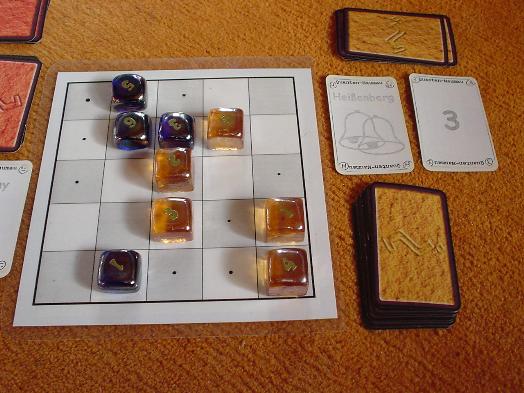
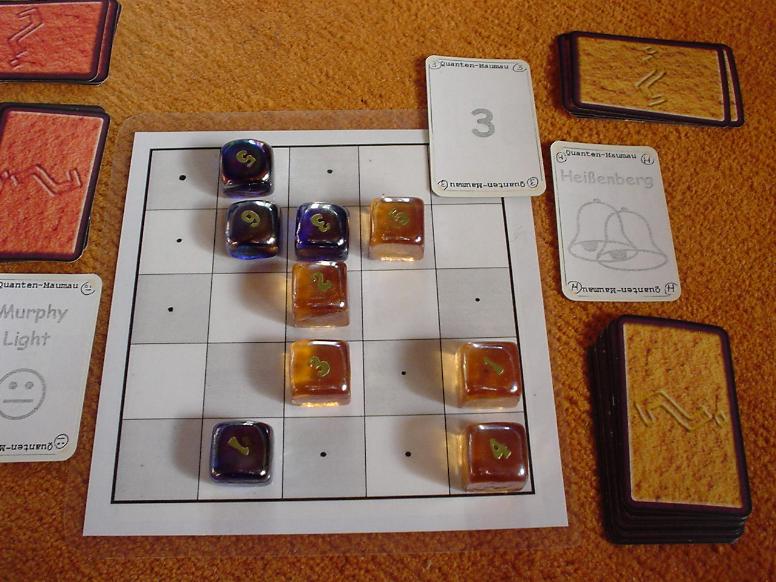
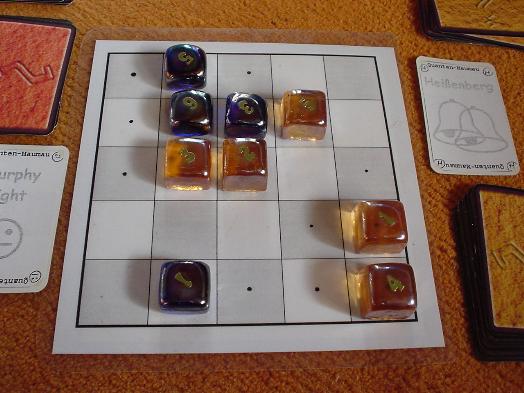
The same procedure as every time, or so.
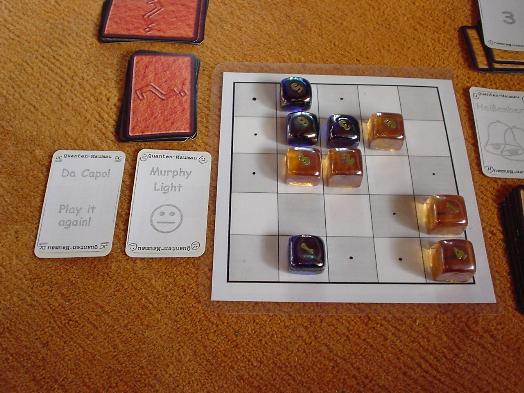
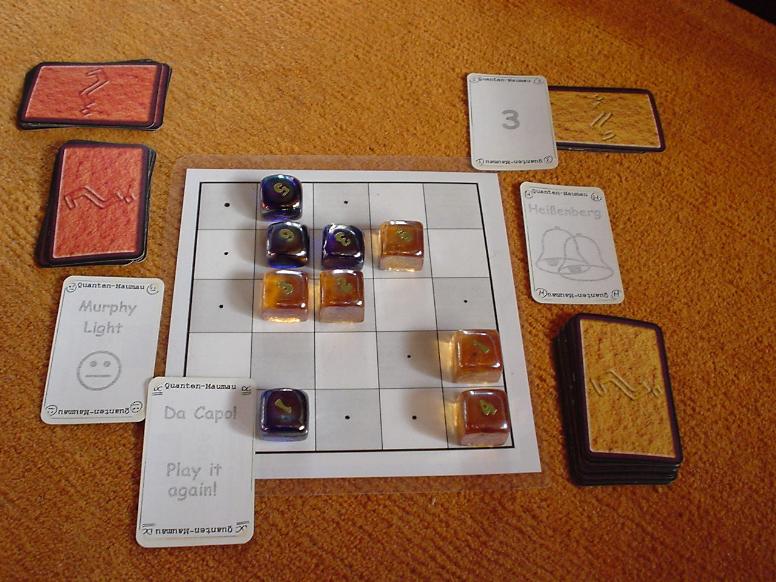
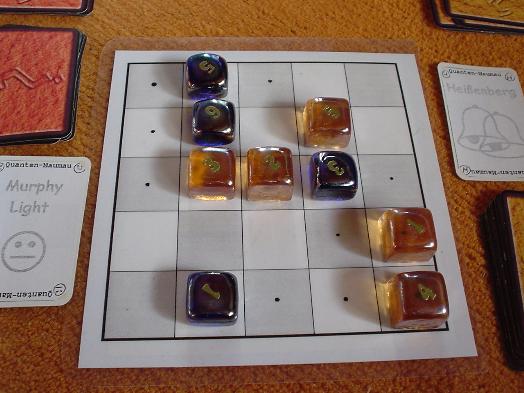
Again, Blue has two interesting cards on his hand. He decides
for Da Capo and has to move according to card "3".
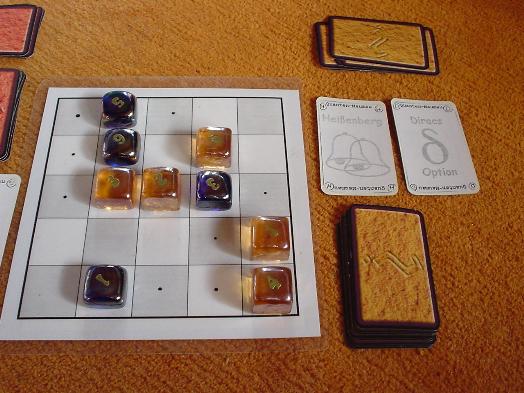
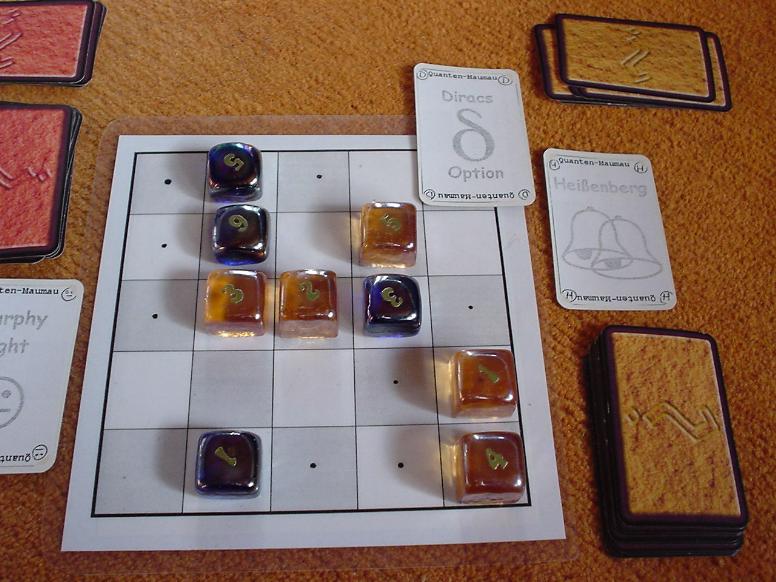
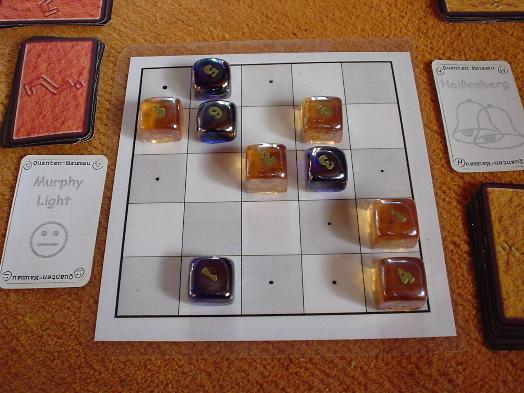
The Dirac now. Orange brings his 3 in position for a final shot.
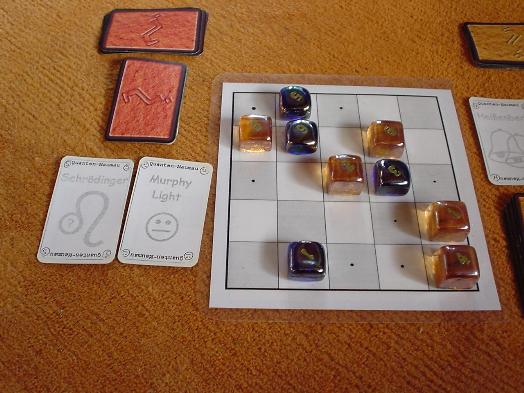
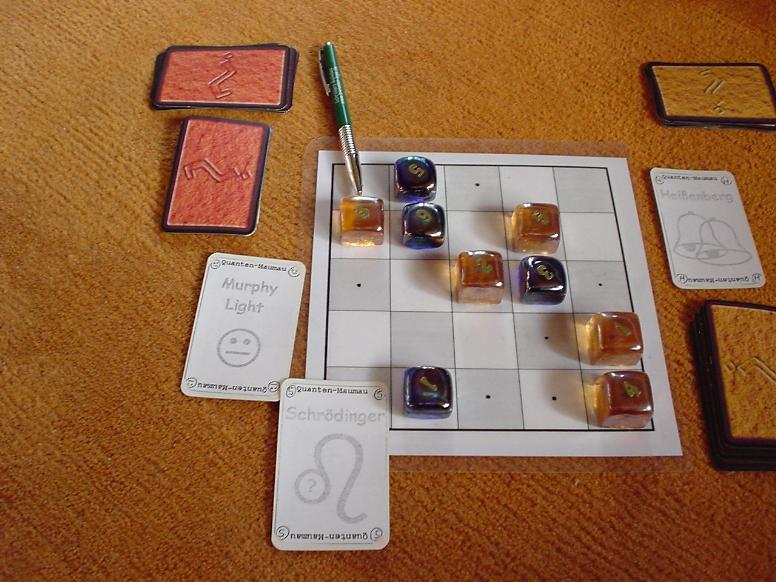
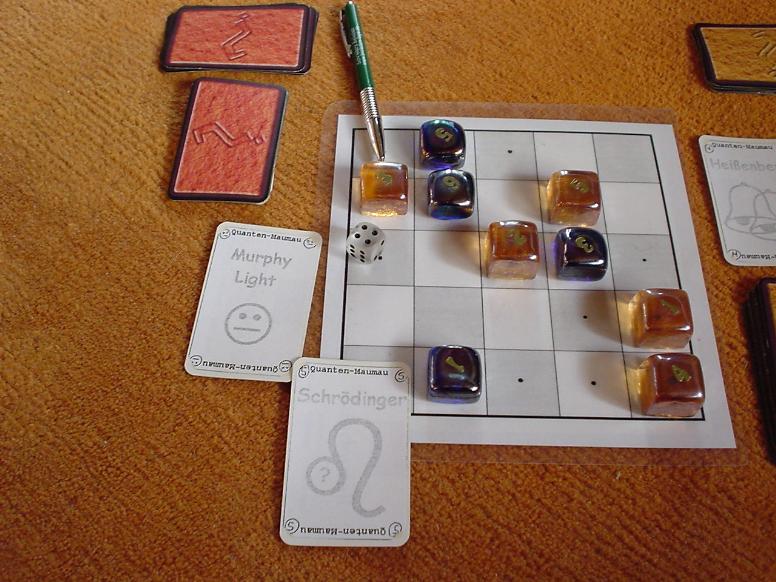
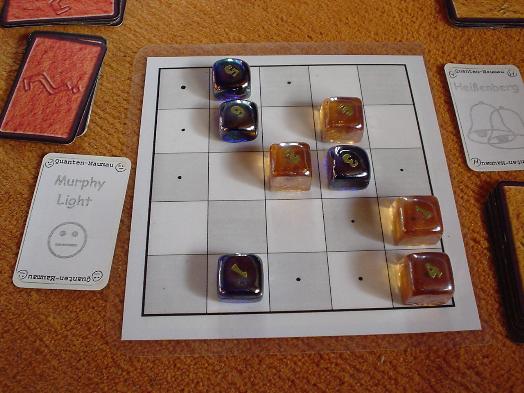
Wow, Blue gets Schroedinger in his hand and plays it immediately.
Of course, he applys the experiment on the 3 of Orange. The die
(showing 4 eyes) is on his side, and he can remove the 3.
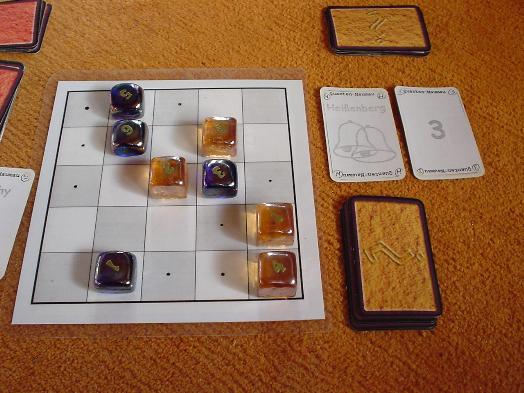
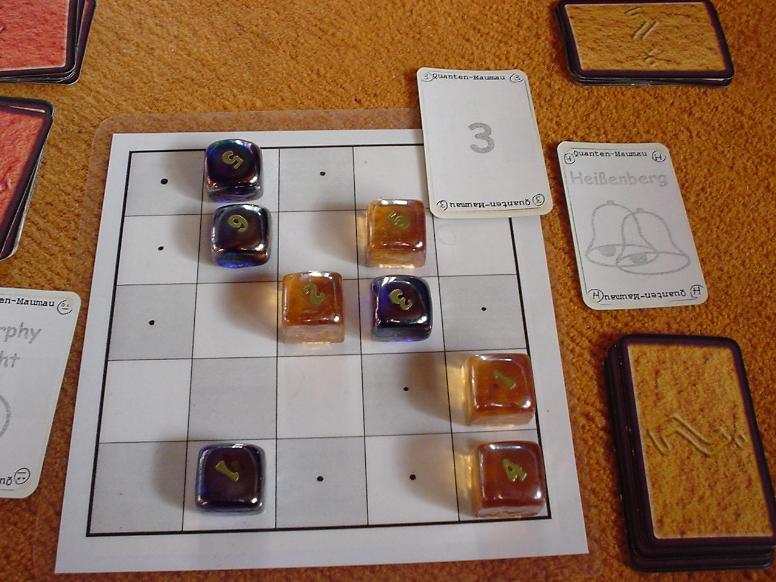
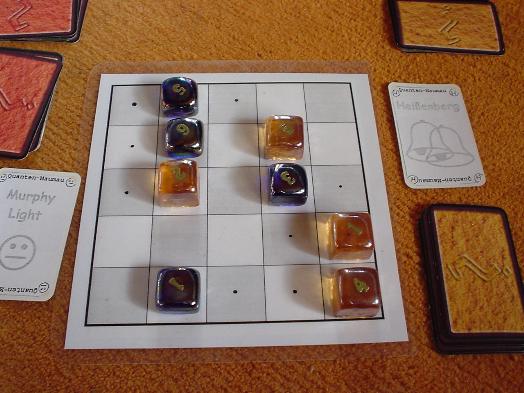
Orange, still in disciplined fighting spirit.
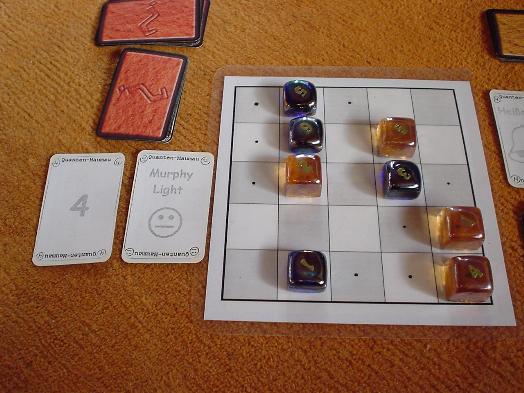
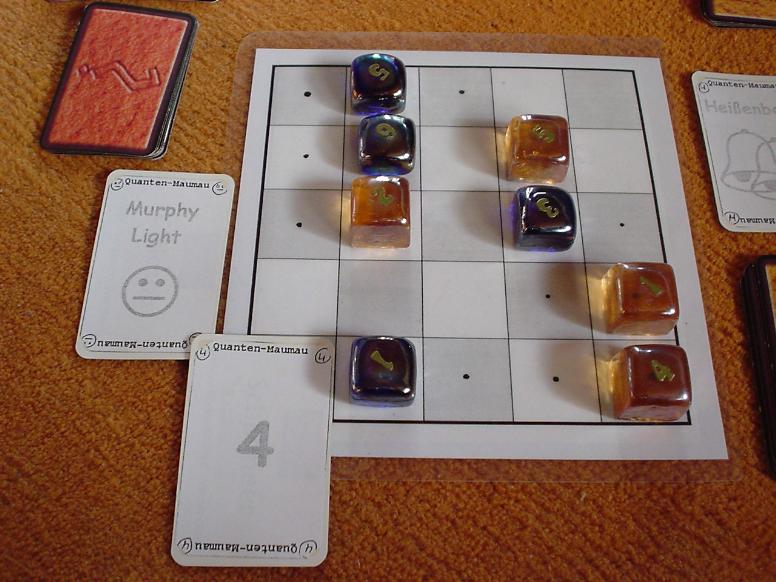
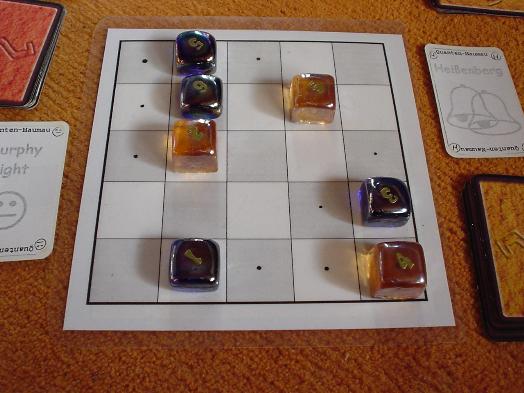
Blue plays the 4, trying a direct attack with his 3.
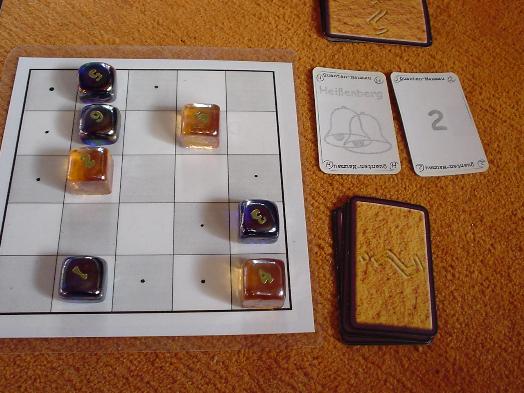
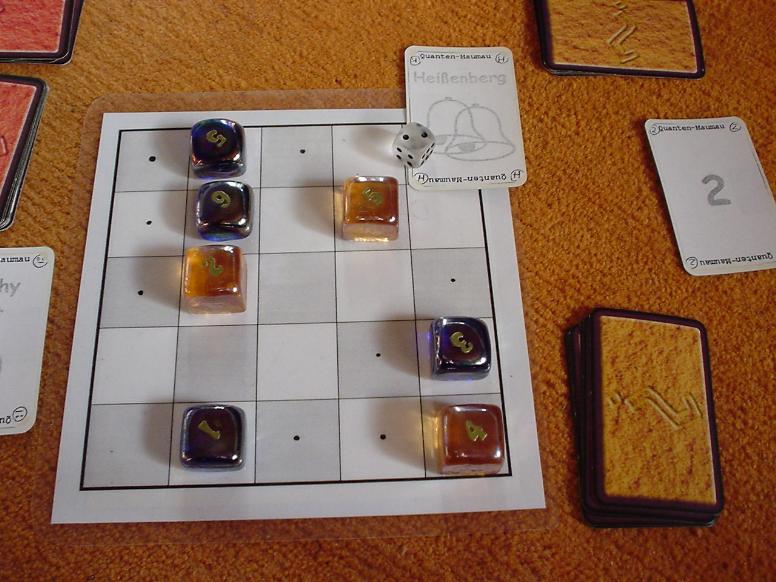
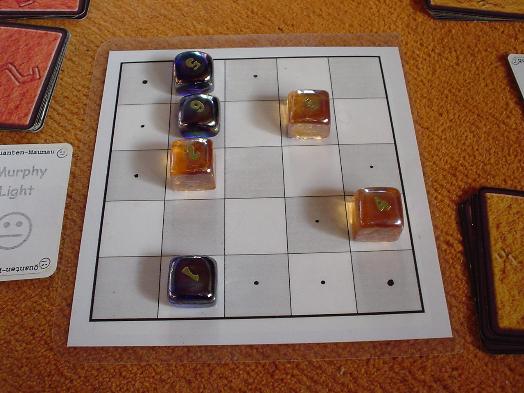
Orange wants to improve his defense chances and plays the Heisenberg.
"2" rolled, interpreted as 3, and the orange 4 captures the blue aggressor.
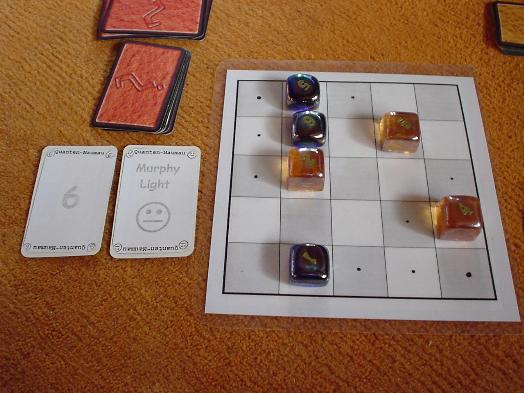
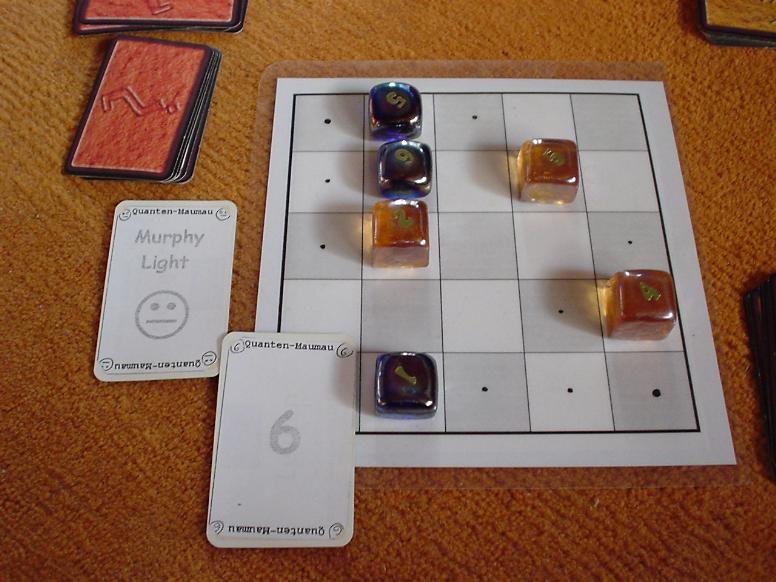
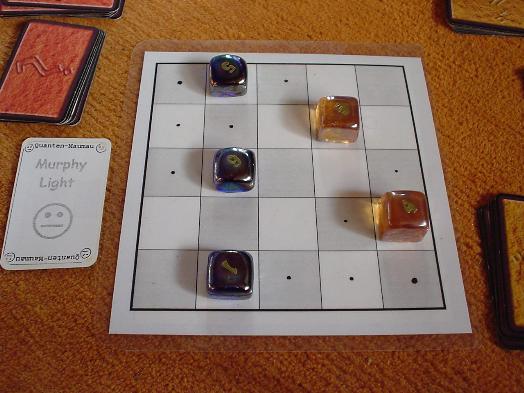
Normal move by the blue 6.
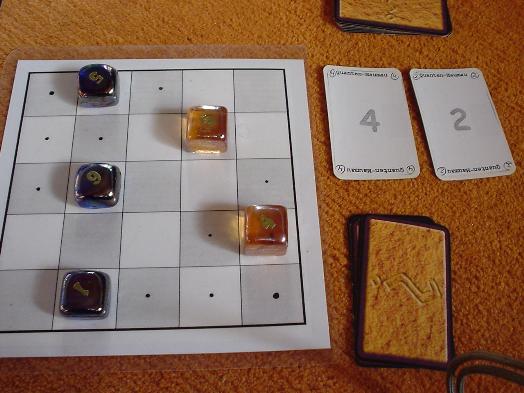
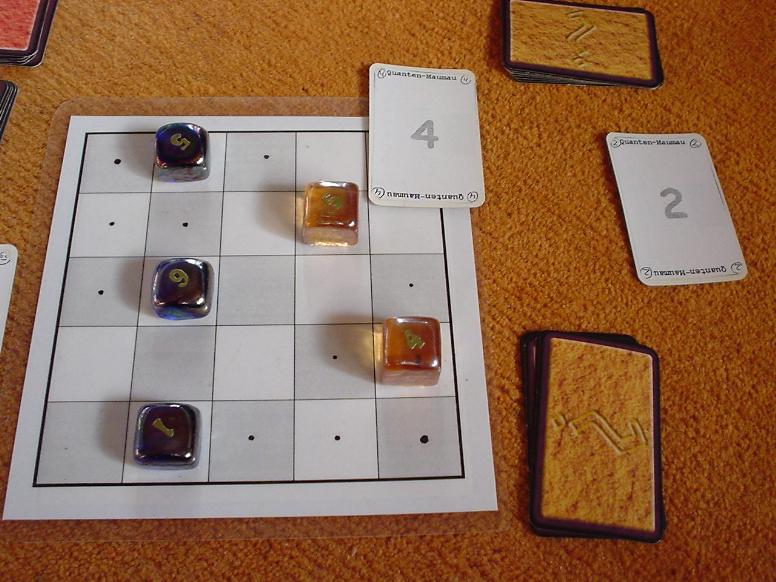
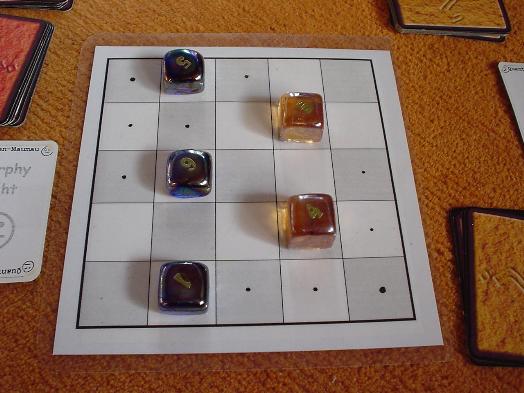
For Orange it does not make a difference if he plays the 2 or the 4.
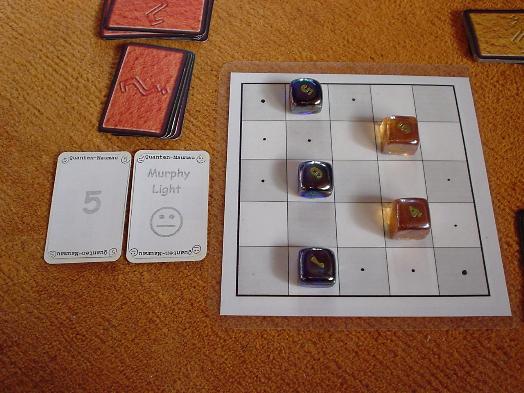
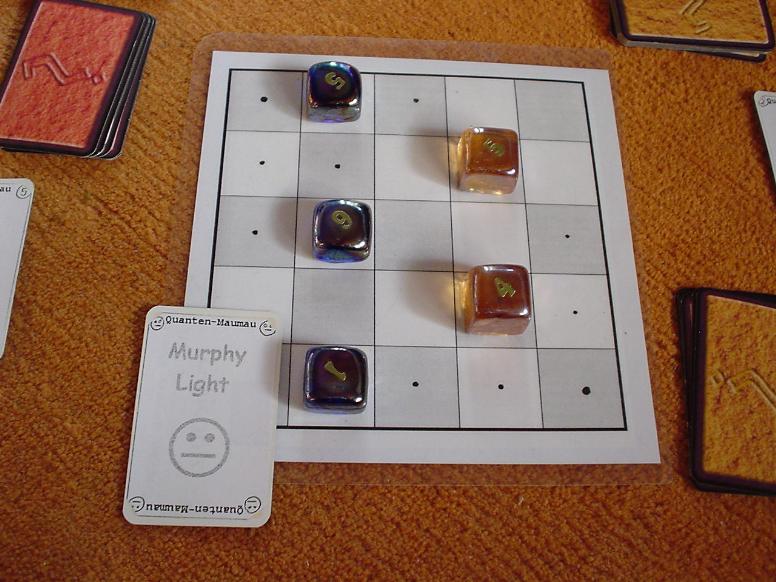
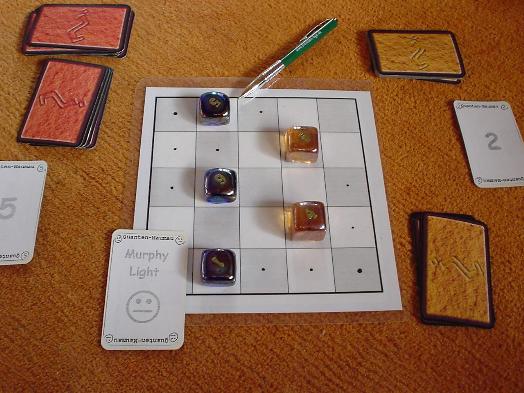
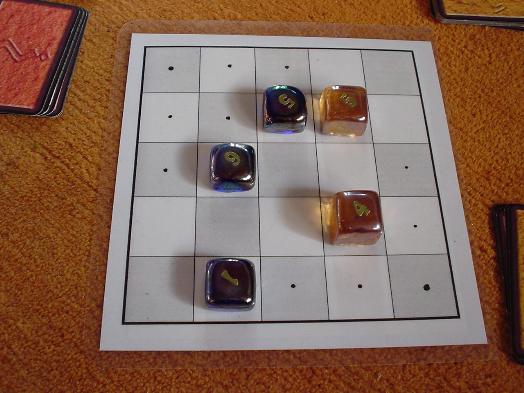
Clever choice by Blue. He gives the Murphy Light away for a very cheap price.
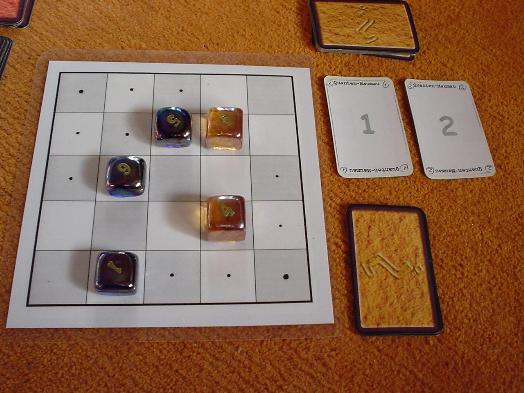
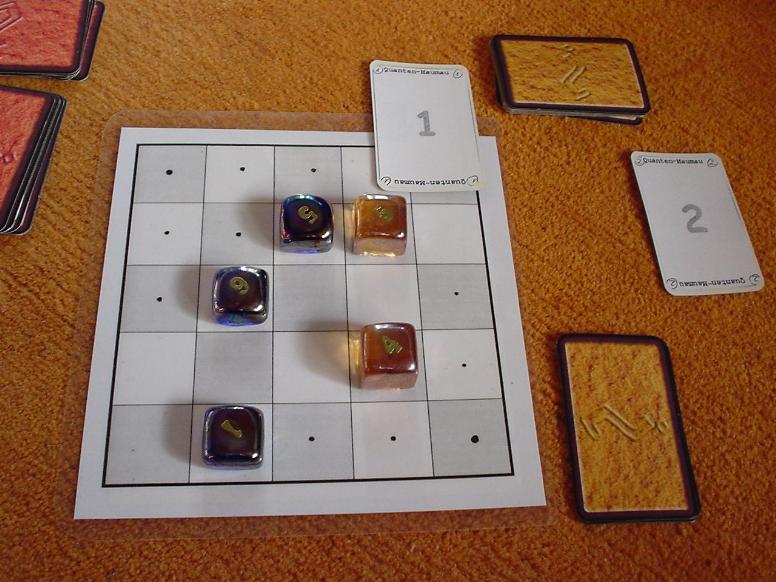
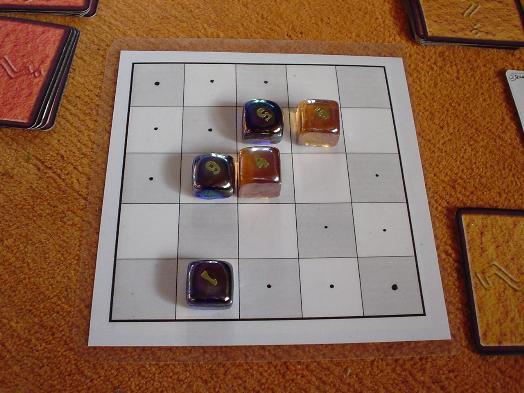
Another situation for Orange without a true choice.
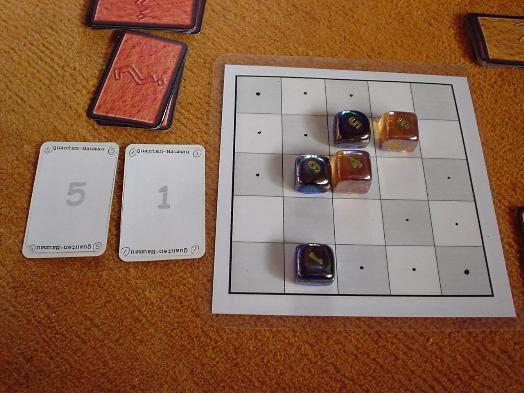
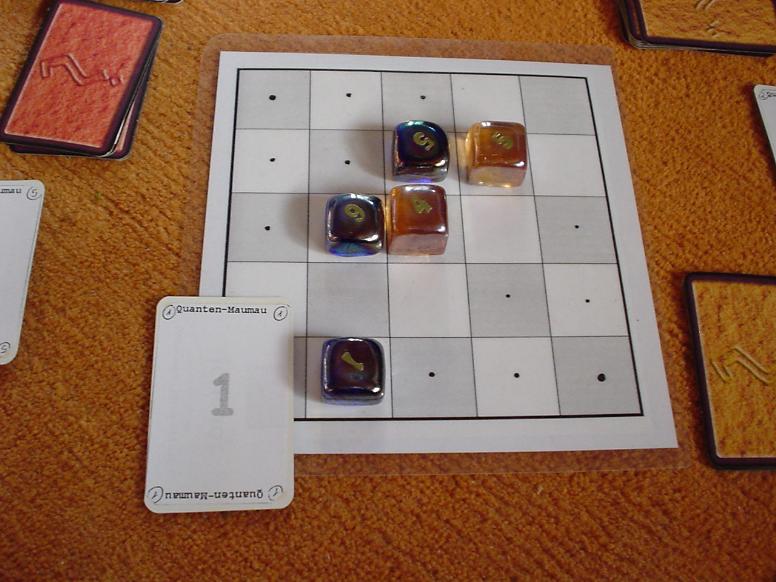
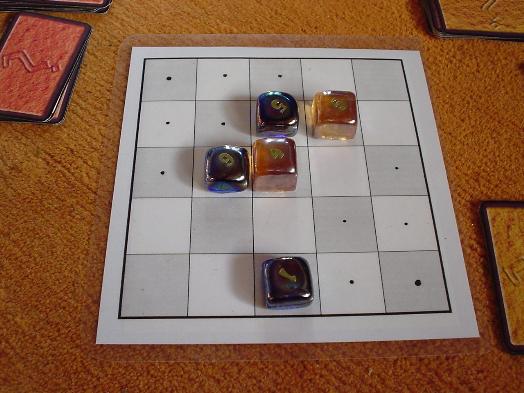
1 is marching for Blue.
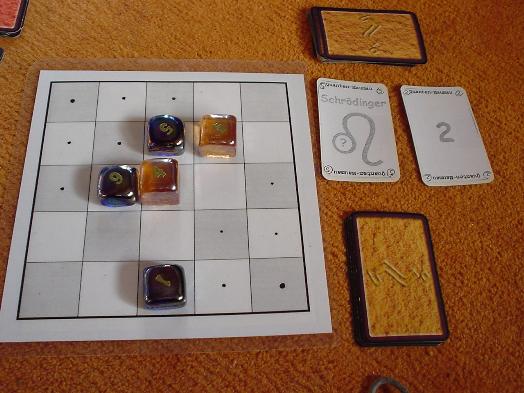
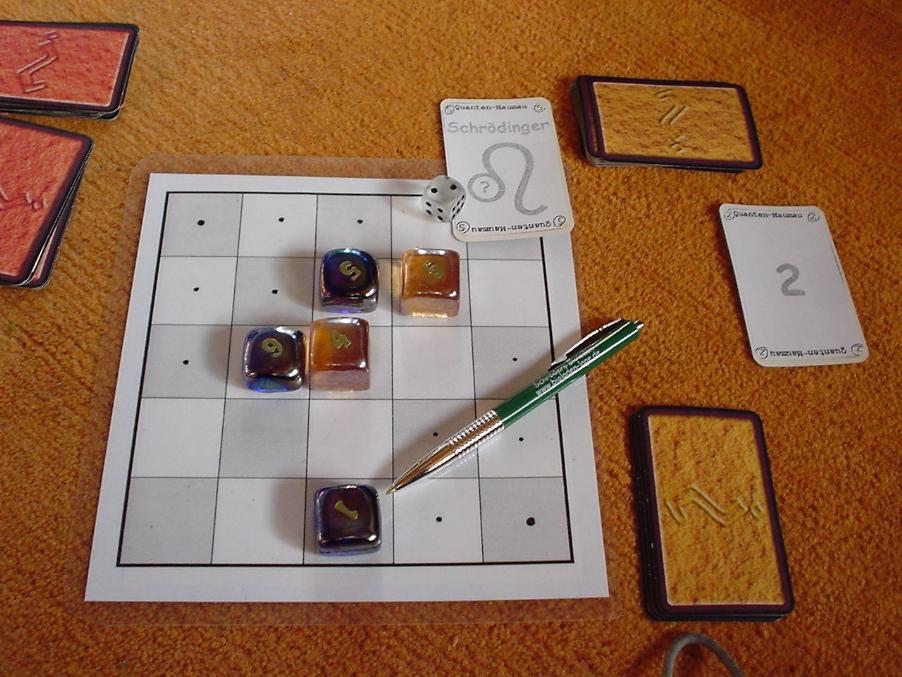
Orange plays the Schroedinger, applying it to the blue 1.
Unfortunately the action fails: the 1 remains on board.
Perhaps, simply playing the 2 and marching through with the
4-stone would have been better.
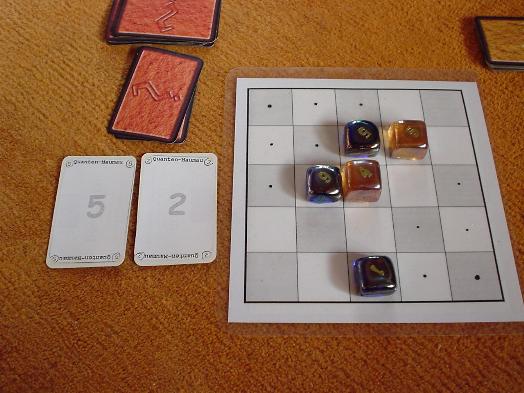
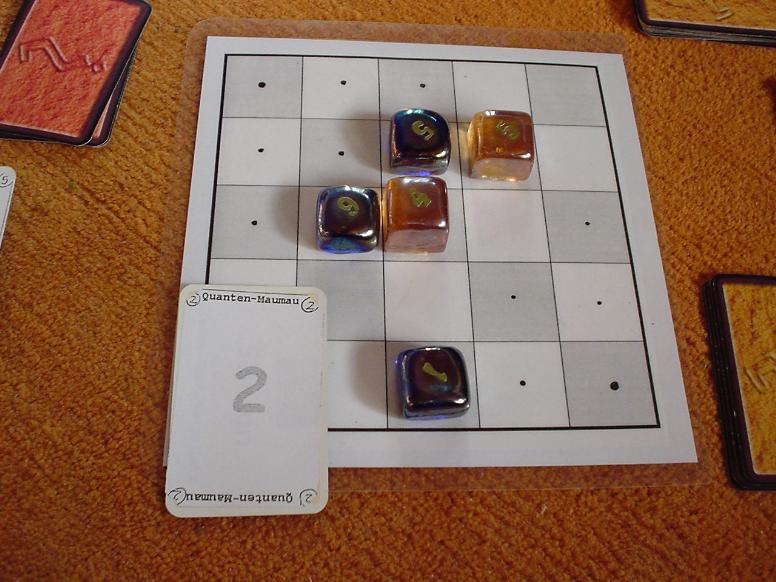
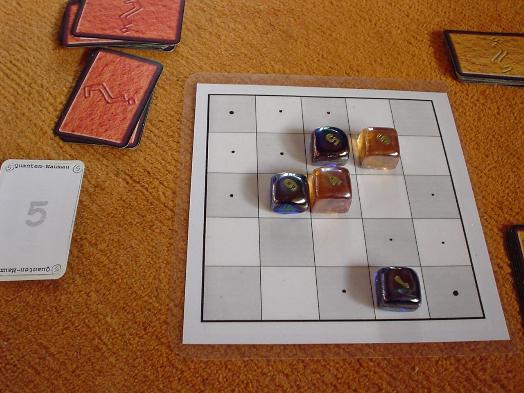
Lucky Blue. His 1 is marching on.
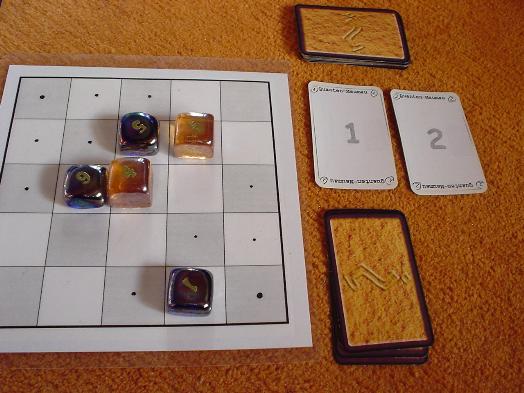
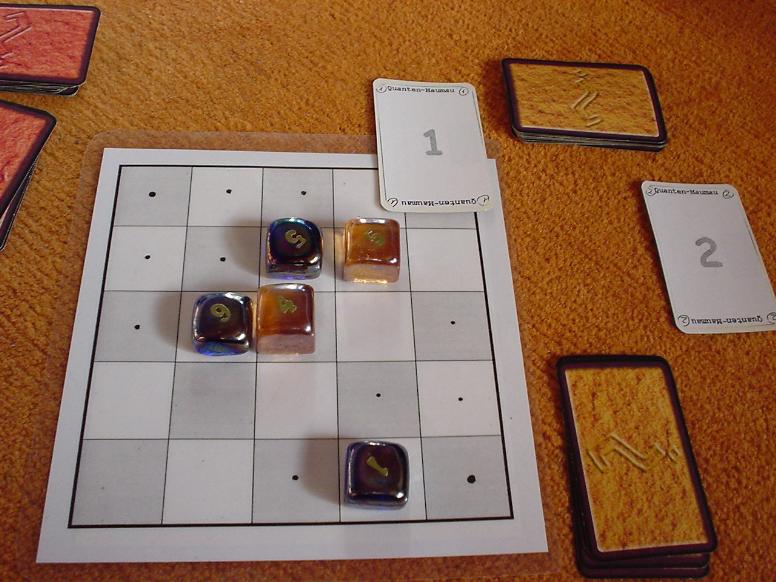
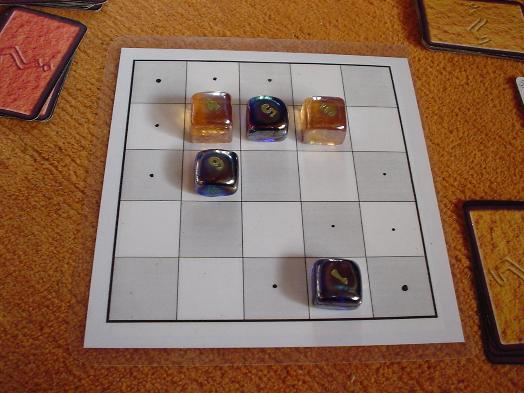
Orange with no choice again. But now he has also a stone ante portas.
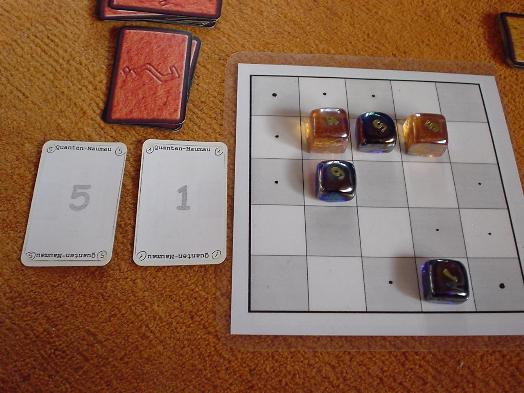
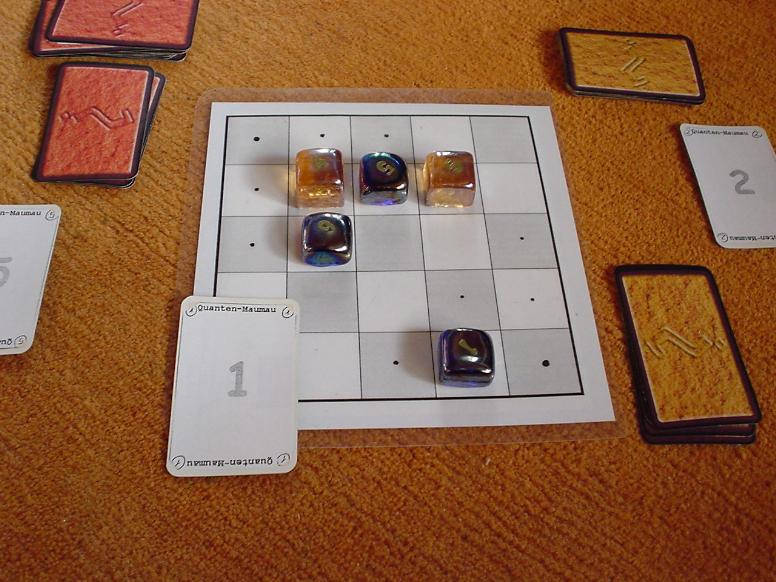
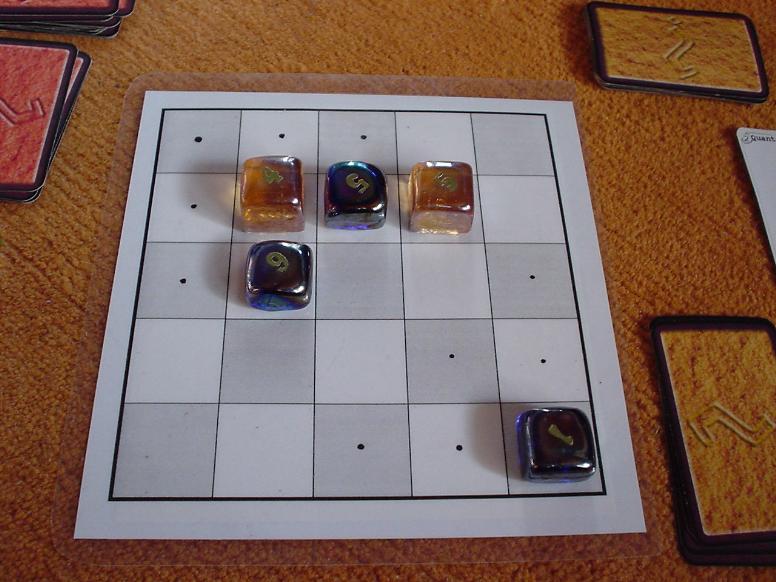
Blue remains in his lucky streak and wins.
If the two players are very different in playing strength,
one of the following handicap settings may be tried.
* Player A has, in normal fashion, always two cards in his hand.
Opponent B, the weaker one, has three cards in his hand. So,
B has more choices in each move.
* The stronger player acts with open cards.
Back to the Events site of 3-Hirn Verlag
























































































